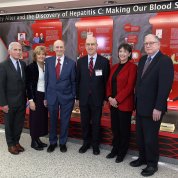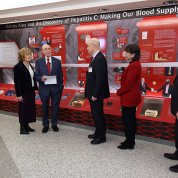CC Exhibit Honors Career of Nobel Laureate Alter

Photo: Chia-Chi Charlie Chang
NIH celebrated a new Clinical Center (CC) exhibit that commemorates the distinguished career of Nobel Laureate Dr. Harvey Alter.
“We are so proud to claim Dr. Alter as our own,” said NIH Director Dr. Monica Bertagnolli, at the exhibition’s official opening on Feb. 14. “Harvey’s brilliant and dedicated research led to several advances that have transformed the safety of the blood supply.”
Alter won the 2020 Nobel Prize in Physiology or Medicine for his contributions to the discovery of the hepatitis C virus. He is one of six Nobelists who conducted the entirety of their award-winning research at NIH and the sole NIH Nobelist to conduct clinical research.
“I never expected a ribbon-cutting and or to see my face on these hallowed walls,” said Alter, now a senior scholar in the CC department of transfusion medicine. Alter’s work contributed to development of blood tests for not just hepatitis C, but also hepatitis B. The tests have improved the safety of blood transfusions, noted CC CEO Dr. James Gilman. Now, the likelihood of experiencing side effects related to transfusion is extremely low.
“Transfusions around the world are safer for millions thanks to Dr. Alter and his colleagues,” said Gilman.

Photo: Chia-Chi Charlie Chang
Alter first arrived at NIH as a clinical associate in November 1961. Had he not joined NIH, he would’ve joined the army. He had been drafted and told to report to Fort Dix, N.J. His appointment at NIH superseded his draft notice.
“Had I been drafted my life would’ve been completely different,” he said. “I would’ve certainly wound up in a clinical practice. That had been my goal all along. I didn’t intend to be a researcher.”
At NIH, he joined the Blood Bank. There, he began collaborating with Dr. Baruch Blumberg. Together, they discovered the Australian antigen.
“In those days, you could go to somebody and say, ‘let’s collaborate,’” Alter recalled. “There were no protocols, no [institutional review boards] IRBs or oversight. We just did what we thought was interesting.”
Subsequently, Blumberg went on to discover that the antigen was the surface coating of the hepatitis B virus. He later won a Nobel Prize for his discovery.
“I got the satisfaction and reward that the first project I ever did turned out to be very important,” Alter said.
He left NIH to complete a hematology fellowship at Georgetown University, where he “got hooked on academic medicine.” Four years later, he was offered the chance to return to the Blood Bank to study transfusion-associated hepatitis.

Photo: Chia-Chi Charlie Chang
“The exhibit gives you a glimpse of a brilliant and generous poet, who is also one of NIH’s great physician-scientists,” said NIH Principal Deputy Director Dr. Lawrence Tabak.
Also speaking at the exhibit opening, Dr. Anthony Fauci, former director of the National Institute of Allergy and Infectious Diseases, said Alter’s work was one of the most important things that happened in the CC. “The CC is the crown jewel of NIH. Harvey has really promoted and validated the concept of how important this particular component of NIH is.”
Alter thanked his wife, Diane Dowling, for making “him a better researcher because I could come to work at ease and I would come home to a loving and supportive wife.” Alter also referred to the many colleagues, mentors and leaders who have supported him over the course of his career. Several attended the exhibit ribbon-cutting.

Photo: Chia-Chi Charlie Chang
“The permanent exhibit in the busy halls of the Clinical Center is a wonderful reminder to the many passersby of why we do what we do,” Bertagnolli concluded. “It can take long hours and many years. But we make a significant impact in clinical care when we try to understand the root causes of illness.”
Michele Lyons, Devon Valera and Mark Riewestahl of the Office of NIH History and Stetten Museum designed the exhibit, which is located in the central corridor of the CC’s Magnuson Bldg., between the FAES bookstore & coffee shop and Masur Auditorium.





